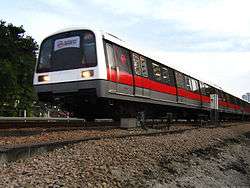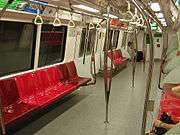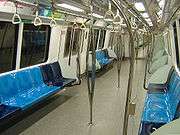Kawasaki Heavy Industries C151
| Kawasaki Heavy Industries (KHI) C151 | |||||
|---|---|---|---|---|---|
|
A refurbished Kawasaki C151 train
| |||||
| In service | 7 November 1987 – present | ||||
| Manufacturer | Kawasaki Heavy Industries (with Nippon Sharyo, Tokyu Car, and Kinki Sharyo)[1] | ||||
| Built at | Kobe, Japan[2] | ||||
| Constructed | 1986 – 1989 | ||||
| Refurbishment |
Hyundai Rotem (with Mitsui, dU LexBuild and RM Transit Technology)[3] 2006 – 2008 | ||||
| Number built |
396 vehicles (passenger service) 4 vehicles (money train) | ||||
| Number in service | 396 vehicles (66 trainsets) | ||||
| Number preserved | 4 vehicles (money train) | ||||
| Formation |
6 cars per trainset DT–M1–M2–M2–M1–DT | ||||
| Capacity |
1920 passengers 372 seats (initial design) 208 seats (after refurbishment) | ||||
| Operator(s) | SMRT Trains (SMRT Corporation) | ||||
| Depot(s) | Bishan, Changi, Tuas and Ulu Pandan | ||||
| Line(s) served | North South Line and East West Line | ||||
| Specifications | |||||
| Car body construction | Aluminium-alloy double-skinned construction[2] | ||||
| Car length |
23.65 m (77.6 ft) (DT) 22.8 m (75 ft) (M1/M2) | ||||
| Width | 3,200 mm (130 in) | ||||
| Height | 3,690 mm (145 in) | ||||
| Doors | 1,450 mm (57 1⁄16 in), 8 per car | ||||
| Maximum speed |
90 km/h (56 mph) (design) 80 km/h (50 mph) (service) | ||||
| Weight |
217 t (214 long tons; 239 short tons) (DT) 38.3 t (37.7 long tons; 42.2 short tons) (M1) 38.4 t (37.8 long tons; 42.3 short tons) (M2) | ||||
| Traction system |
Original: 4-quadrant/GTO chopper control (Mitsubishi Electric)[4] Upgraded: IGBT-VVVF (Toshiba, 055/056 and 131/132 only)[5] | ||||
| Traction motors |
Original: Two-phase DC shunt-wound motor (Mitsubishi Electric) 145 kW (194 hp) 375 V 430 A 2050 rpm (1 hour rating) Upgraded: Permanent Magnet Synchronous Motor (Toshiba, 055/056 and 131/132 only) | ||||
| Power output | 2.32 MW (3,110 hp) | ||||
| Transmission |
Westinghouse-Natal (WN) drive; Gear ratio: 6.57 : 1 | ||||
| Acceleration | 1.0 m/s2 | ||||
| Deceleration |
1.0 m/s2 (service) 1.3 m/s2 (emergency) | ||||
| Electric system(s) | 750 V DC third rail | ||||
| Current collection method | Collector Shoe | ||||
| Bogies | H-frame Bolsterless (Siemens)[1][2] | ||||
| Braking system(s) |
Electro-pneumatic, regenerative and rheostatic (Westinghouse Brake and Signal)[2][6] | ||||
| Safety system(s) |
Current: Westinghouse Brake and Signal Company Ltd ATC with subsystems of ATO GOA 2 (STO), ATP and ATS Thales SelTrac CBTC, ATC with subsystems of ATO GOA 2 (STO), ATP, NetTrac ATS, CBI[7] | ||||
| Coupling system | Scharfenberg[1][2] | ||||
| Track gauge | 1,435 mm (4 ft 8 1⁄2 in) | ||||
The Kawasaki Heavy Industries C151 is a type of train that is one of the four current types of electric multiple unit on the North South and East West Lines of Singapore's Mass Rapid Transit (MRT) system. These are the oldest trains built for the system; they were introduced in 1987 and are still in operation. Sixty-six trainsets consisting of six cars each and a single money trainset consisting of four cars were purchased. These trains are operated by SMRT Trains.
These trains were manufactured from 1986 to 1989 in batches by a Japanese consortium consisting of Kawasaki Heavy Industries, Nippon Sharyo, Tokyu Car Corp and Kinki Sharyo following a round of intense competitive bidding by rolling stock manufacturers from around the world. No visible differences can be found in any of these batches, which were built to agreed specifications.
The trains underwent a two-year mid-life interior refurbishment programme by Hyundai Rotem. After major train disruptions on 15 and 17 December 2011, further plans to upgrade its mechanical components to increase its reliability were made. The first trainset to receive this upgrade, which included a replacement traction system, entered service in July 2015.
History
Tendering process
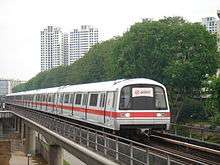
With construction of the Mass Rapid Transit system underway in 1983, Contract 151 called for the procurement of rolling stock—150 cars in Phase One and an option for 246 cars in Phase Two.[8] In what Financial Times described as "a time when manufacturers were begging for orders" for the global rolling stock market,[9] competition for the contract was intense. At least eight companies from around the world submitted bids for what they had nicknamed the "Big One".[8] Bidders included Metro-Cammell with Singapore Automotive Engineering, Kawasaki Heavy Industries with three Japanese manufacturers, MAN AG with AEG, Siemens and Brown, Boveri & Cie, Francorail with Alsthom-Alantique, SOFRETU and Singapore Shipbuilding and Engineering, ASEA with Sembawang Shipyard, and a Bombardier Transportation-led consortium with Hawker Siddeley Canada and Brown Boveri Canada.[10][11]
Competition for the contract was so fierce that it involved last-minute discounts, offers of free parts and allegations of sabotage.[1][8] Metro-Cammell, Kawasaki and ASEA were shortlisted for the final round.[10][12] Metro-Cammell based its design on the Hong Kong MTR M-Train EMU and proposed to use the GEC propulsion system had they won the contract.[1] Metro-Cammell also delivered a concept mock-up and was originally the favourite to win the contract.[8] However, analysts became concerned that a measuring error involving the London Underground 1983 Stock during the evaluation period could jeopardise their bid.[13][14]
In 1984, the Japanese consortium of Kawasaki Heavy Industries with Nippon Sharyo, Tokyu Car Corp and Kinki Sharyo was awarded Contract 151 at a cost of S$581.5 million for the construction of 396 passenger cars.[1][15] Kawasaki won the contract; its bid—aided by favourable financing from Mitsui and positive economic conditions in Japan—was 12% lower than those of other bidders.[9][16] The award was the largest single contract awarded in the initial construction of the system.[9] Kawasaki also promised to supply $20.9m worth of complimentary spare parts after delivery.[17] The loss of Contract 151 was a massive financial blow to Metro-Cammell, who were forced to reduce their workforce by half later that year.[18]
Initial construction
A mock-up was manufactured in Japan after Kawasaki won the contract.[19] It was shipped to Singapore and put on public display during the 1984 National Exhibition held in November 1984 at World Trade Centre.[19] The mock-up featured three choices of seating arrangements and colour schemes; members of the public were invited to give feedback on these options.[19] The finalised interior design of the C151 trains consisted of a fully longitudinal seating arrangement.[20] The bucket seats were made of plastic; glass partitions separated the seating areas from the passenger doors.[20] Strap lines for standing passengers were installed in the middle of every car.[20] The colour scheme of each adjacent car's interior is distinct to make car identification in cases of fault reporting easier for passengers.[20] Originally the colour scheme of the driving trailer cars was orange, that of the second and fifth motor cars was blue, and that of the two centre motor cars was green.[2] There were nine seats between two doors; this was reduced to seven after the first round of refurbishment.[20]
While the rolling stock and Mitsubishi Electric propulsion equipment were constructed in Japan, many parts were sourced from Europe. The trains were fitted with Stone Platt air-conditioning, Duwag bogies, Sig gangways, Scharfenberg couplers and Westinghouse brakes.[1][2][21] Mitsubishi Electric's propulsion equipment was estimated to consume 50% less electricity than Hong Kong's existing MTR M-Train EMU.[2] Its Automatic Train Control (ATC) signalling system was supplied by Westinghouse, capable of running at pre-programmed speeds and activated by the train driver.[22] While theoretically possible to design for a fully driverless operation using this signalling technology, MRT Corporation (MRTC, now SMRT Corporation) decided against this option.[22] The trainsets were assembled in Kobe, Japan, and then shipped to Singapore by Neptune Orient Lines.[17] The first trainset was delivered to MRTC on 8 July 1986 at Bishan Depot, officiated by Yeo Ning Hong.[2][23]
First refurbishment
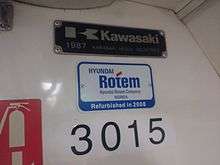
On 3 September 2004, Hyundai Rotem, Mitsui, RM Transit Technology and dU LexBuild received an order to refurbish all 396 carriages, costing S$142.7 million in total.[3] The works included the refurbishment of interior fixtures, the addition of wheelchair spaces, the upgrading of onboard communications equipment, enhancement of the public announcement system, and general improvement of the cars' appearance.[24] SMRT Corporation said the reasons for refurbishment were wear and damage of important components over the past two decades and water leaks from the air-conditioning system on some trains.[24] The company chose this option instead of buying new rolling stock, which would have cost S$792 million.[24] The first refurbished train began revenue service on 5 November 2006, and all remaining trainsets had been refurbished by the end of 2008.[24]
The exteriors of refurbished trains resemble those of the C751B rolling stock. The interior fittings were replaced with white walls and new seats and installed further back to allow more standing space. The colour of seats in the driving trailer was changed from orange to red.[24] Seats of the refurbished cars were lengthened from 43 cm (17 in) to 48 cm (19 in). Four of seven seats per row were designated as priority seats and were differentiated using a darker colour.[25]
The Mitsubishi Electric propulsion system was retained, having performed better than expected.[24] The wheelchair space was made available on the end of two mid-train cars, nearest to the lifts in above-ground stations. LED displays that blink to warn passengers of closing doors were introduced in the upper middle section of the door.[24] Additional loudspeakers and advertisement panels were also introduced. Hand grips were moved to the support bars of the seats on the ceiling and grabpoles were located near the doors and at both ends of each carriage. The air-conditioning system was modified to match the system used in the C751B cars, with air-conditioning vents and in-flow fans installed.[24]
In November 2008, SMRT Corporation and Land Transport Authority (LTA) announced that the last ten refurbished trainsets would have one-third of their seats replaced with metal rails to create extra standing space.[26][27] The move was justified on grounds of allowing more standing space onboard during peak-hour services.[26][27] The reduction of seats per row from nine to seven after refurbishment was already unpopular among commuters;[28] the decision to further reduce seating capacity drew sharp criticism against the operator and LTA. As of December 2015, all 66 C151s from one-third of their seats have been replaced by metal bars to create extra standing space.[29][30][31][32]
Second proposed refurbishment and replacement
Following major train disruptions on 15 and 17 December 2011, the Committee of Inquiry (COI) found that despite the first refurbishment of the C151 rolling stock, "there does not appear to be any upgrade in terms of engineering components".[33] The COI was particularly critical of the inadequate and ageing emergency battery installed on the C151 and recommended the installation of a Train Integrated Management System (TIMS) found on the C751B and C151A trains.[33]
In response, SMRT announced it was replacing important engineering components on all C151 trains by 2019.[34] This included changing the existing Mitsubishi Electric propulsion system for the newer Insulated-gate bipolar transistor (IGBT) and Permanent Magnet Synchronous Motor (PMSM) propulsion system by Toshiba, technology currently used in the Tokyo Metro's 1000 series and 16000 series trains as well as the Kyushu 305 series and Hankyu 1000 series trains.[5] As of July 2015, train sets 055/056 and 131/132 are trialed with the new propulsion system. In tandem with the replacement of the signalling system on the East-West Line and North-South Line with the newer Thales SelTrac signalling system, new equipment are installed in the passenger compartment of the trailer cars.[7]
However in August 2016, LTA has placed this refurbishment programme on hold after acquisition of SMRT rail assets on August 2016 due to the concerns and issues with older trains. LTA is evaluating on the decision to replace older trains with newer ones, despite the frames of the older trains being sturdy for decades. SMRT is expected to suffer some losses if the decisions of replacement is confirmed as the parts for refurbishment has been purchased.[35] In October 2016, LTA announced that it will be calling for a tender of new trains to replace all C151 trainsets.[36][37]
Operational details
Money train
Kawasaki built a four-car unit to serve as a money train.[38][39] This was decommissioned from service in 2007 and both set 301 and 302 are used by the Singapore Armed Forces (SAF) for training purposes. The mock-up C751B is used for the ITE College West for training purposes.
Passenger announcement and information systems
These trains originally had no visual passenger information systems; station announcements had to be made by the train operator.[40] An automatic audio announcement system using voice synthesizers was installed on each train by September 1994.[40] The first iteration of the door closing buzzer announcements, which replaced the initial door chimes, was fully introduced by April 1997.[41]
SMRT first attempted to install a passenger information system SMRTime on trains using LCD displays in 1999; these have since been removed.[42] In November 2006 the doors of three cars (carriage number 3006, 1006 and 2006) were installed with a dynamic, in-train system displaying station information for testing; these are similar to ones used by Hong Kong's MTR.[43] An initial prototype of STARIS based upon the existing Automatic Transit Info System was developed in-house; this was removed before the end of the year without entering service.[43]
Two years later, four units of vacuum fluorescent displays (VFD) were mounted on the ceiling. Eight units of dynamic route maps were mounted above every door in each car in trainset 053/054 for a two-month trial.[43] This new SMRT Active Route Map Information System (STARiS) was then progressively introduced to all C151 trainsets, and subsequently to C651 and C751B trains for a cost of S$12 million—S$20,000 per car.[43][44] It became standard equipment on all new rolling stocks subsequently introduced on the East-West Line and North-South Line.
Livery and numbering
The cars had an aluminium-alloy double-skinned construction, and were delivered unpainted to save time.[20] A red adhesive strip ran through the length of the cars in the middle to match the operator's visual branding.[2][20] The unpainted cars had a shiny appearance upon delivery, but as dirt and grime accumulated it became a recurring problem for the operator and attracted several public complaints.[45] In response, MRT Corporation built a wash machine at Bishan Depot in an attempt to clean up the cars' exterior proper.[46] After refurbishment, the problem was solved by covering the cars' exterior entirely with giant stickers, creating a livery that is similar to the newer C751B and C151A rolling stocks.[25]
Train formation
A complete six-car trainset consists of an identical twin set of one driving trailer (DT) and two motor cars (M1 and M2) permanently coupled together.[47] The configuration of a C151 trainset in revenue service is DT–M1–M2–M2–M1–DT.
| Cars of C151 | ||||||||||
|---|---|---|---|---|---|---|---|---|---|---|
| car type | Driver Cab | Motor | Collector Shoe | car length | Wheelchair Space | |||||
| mm | ft in | |||||||||
| DT | ✓ | ✗ | ✓ | 23,650 | 77 ft 7.1 in | |||||
| M1 | ✗ | ✓ | ✓ | 22,800 | 74 ft 9.6 in | |||||
| M2 | ✗ | ✓ | ✓ | 22,800 | 74 ft 9.6 in | |||||
The car numbers of the trains range from x001 to x132, where x depends on the carriage type. Individual cars are assigned a 4 digit serial number by the rail operator SMRT Trains. A complete six-car trainset consists of an identical twin set of one driving trailer(DT) and two motor cars(M1 & M2) permanently coupled together. For example, set 099/100 consists of carriages 3099, 1099, 2099, 2100, 1100 and 3100.
- The first digit identifies the car number, where the first car has a 3, the second has a 1 & the third has a 2.
- The second digit is a 0 or 1, part of the identification numbers
- The third digit and fourth digit are the train identification numbers. A full length train of 6 cars have 2 different identification numbers, one for the first 3 cars, and the same number plus 1, for the other three.
- Kawasaki Heavy Industries built sets 001–020, 051–062, and 093–102
- Kinki Sharyo co-built sets 021–030, 063–072, and 103–112
- Nippon Sharyo co-built sets 031–040, 073–082, and 113–122
- Tokyu Car Corporation co-built sets 041–050, 083–092, and 123–132
Major incidents
Since its introduction, C151 rolling stock has been involved in three high-profile incidents:
- On 5 August 1993 two C151 trains collided at Clementi station because of a 50-litre (11 imp gal; 13 US gal) oil spillage on the track by a maintenance locomotive, resulting in 132 injuries.[48][49]
- On 17 May 2010, Oliver Fricker trespassed and vandalised car 1048 (trainset 047/048) with graffiti at Changi Depot.[50][51] The graffiti was initially mistaken for an advertisement and was not spotted until the car was filmed and the video was uploaded to YouTube by a trainspotter.[52][53] Fricker was convicted and sentenced to seven months' imprisonment and caning.[53] The public perceived this incident to have serious security implications, as the depot was considered a sensitive installation.[51]
- In the major MRT disruption of 15 December 2011, one C151 train (trainset 067/068, T139 in the COI) was stalled in the tunnel and its backup battery failed.[54] The passenger compartments in T139 experienced a blackout and loss of ventilation, leading to one passenger smashing a train door window to avoid suffocation.[54][55] The battery failure led to criticism by the COI on the condition of the aging emergency batteries installed on all C151 trains.[33] SMRT has since proposed an upgrading plan to address this issue.[34]
Minor incidents
- On 25 May 2012, a C151 train's glass window panel was reportedly to be shattered on its own at Admiralty causing no injuries or death.[56] This is unrelated to similar issue as well as other defects found on the C151A trains as acknowledged by the SMRT on 5 July 2016.
References
- 1 2 3 4 5 6 7 Sherwell, Chris (12 April 1984). "Kawasaki wins major Singapore metro contract". Financial Times. Factiva. p. 1.
- 1 2 3 4 5 6 7 8 9 10 Dhaliwal, Ray (8 July 1986). "A milestone for the fast track". Straits Times. NewspaperSG (NLB). p. 7.
- 1 2 シンガポールにおける地下鉄電車改修案件の受注について (Press release) (in Japanese). Mitsui (Archived). 3 September 2004. Archived from the original on November 13, 2009. Retrieved 8 November 2008.
- ↑ "Mitsubishi Electric of Japan has won a contract worth over S$100m to provide the propulsion system for Singapore's Mass Rapid Transit (MRT) trains.". Textline Multiple Source Collection. 9 June 1984.
- 1 2 Hoe, Pei Shan (5 July 2013). "Older MRT trains to get new motors from Japan". Straits Times. Retrieved 13 May 2015.
- ↑ Sherwell, Chris (15 June 1984). "World Trade News: UK group wins Singapore order for braking system". The Financial Times. p. 5.
- 1 2 Fang, Joy (2 February 2012). "Coming: $600m upgrade for MRT system/New train measures a 'catch-up'". My Paper. pp. A2, A6. Retrieved 13 May 2015.
- 1 2 3 4 Sherwell, Chris (25 January 1984). "The fight for Singapore's underground : Chris Sherwell in Singapore describes the battle for a major contract". Financial Times. Factiva. p. 10.
- 1 2 3 Sherwell, Chris (16 April 1984). "Hard work by Japanese on bid rewarded with subway contract". Financial Times. Globe and Mail. p. IB7.
- 1 2 Duffy, Hazel (12 May 1983). "World Trade News: Singapore short-lists UK company for metro". Financial Times. Factiva. p. 4.
- ↑ Sherwell, Chris (14 November 1983). "Financial Times Survey: Singapore — Speeding into the 1990s — The mass rapid transit project". Financial Times. Factiva. p. 8.
- ↑ "British, Japanese and Swedish manufacturers are apparently being considered as suppliers of the automatic trains for Singapore's Mass Rapid Transit Corporation". Financial Times. Factiva. 16 February 1984. p. 6.
- ↑ Duffy, Hazel (12 January 1984). "Train fault may hinder Singapore metro bid". Financial Times. Factiva. p. 5.
- ↑ "New coaches built by Metro-Cammell for London Transport have been returned because they are 18mm too wide.". Textline Multiple Source Collection. Factiva. 12 January 1984.
- ↑ シンガポール向け地下鉄電車を納入 (in Japanese). Kawasaki Heavy Industries (Archived). Archived from the original on March 24, 2010. Retrieved 2008-11-08.
- ↑ Sherwell, Chris (12 April 1984). "How Japan finally clinched the deal: The Singapore Underground Contract". Financial Times. Factiva. p. 22.
- 1 2 Dhaliwal, Rav (12 April 1984). "Made-in-Japan MRT trains". Straits Times. NewspaperSG (NLB). p. 1.
- ↑ Barling, Lorne (22 August 1984). "More Metro-Cammell jobs go as orders drop". Financial Times. Factiva. p. 2.
- 1 2 3 Lee, Constance (11 October 1984). "Mock-up of MRT train to be shown at National Exhibition". Straits Times. NewspaperSG (NLB). p. 1.
- 1 2 3 4 5 6 7 Mass Rapid Transit Corporation (MTRC) and Institution of Engineers Singapore (IES) (April 1987). Mass Rapid Transit System: Proceedings of the Singapore Mass Rapid Transit Conference. Singapore. pp. 411–424. ISBN 9971-84-636-5.
- ↑ "Essentially Singaporean - # 2 The MRT". Straits Times. Factiva. 9 August 1992.
- 1 2 Dhaliwal, Rav (28 April 1987). "Getting to know the how it will work". Straits Times. p. 19.
- ↑ Tan, Sumiko (1996). Kim Seng: a reflection of Singapore's success. Kim Seng Publication Committee. p. 76. ISBN 981-00-8576-1.
- 1 2 3 4 5 6 7 8 Rajan, T. (5 November 2006). "MRT trains get $145m overhaul". Straits Times.
- 1 2 Rajan, T. (5 November 2006). "Upgraded trains can take in 100 more commuters". Straits Times.
- 1 2 Popatlal, Asha (30 October 2008). "Train operating standards tightened; Boon Lay Extension to open in Feb". Channel NewsAsia. Retrieved 22 February 2009.
- 1 2 Almenoar, Maria (12 November 2008). "Fewer seats on train". Straits Times.
- ↑ Yew Teck, Chua (9 November 2011). "Refitted SMRT trains should have more seats". Straits Times (Forum).
- ↑ Yap, Camillus (22 November 2008). "No thanks: Why commuter hasn't taken a train in two years". Straits Times Forum.
- ↑ Edward Say, Chia Choon Leng, Tan Chin Aik et alii (26 November 2008). "Seatless cabins won't ease crowded MRT". The Straits Times Forum.
- ↑ Ee, Eoin (28 November 2008). "More trains, not fewer seats". The New Paper.
- ↑ Shao Yi, Tan (28 January 2009). "Designs not user-friendly". Straits Times Forum.
- 1 2 3 Report of the Committee of Inquiry into the Disruption of MRT Train Services on 15 and 17 December 2011, Ministry of Transport, pp. 313-319.
- 1 2 Sim, Royston (15 May 2013). "Older SMRT trains to get makeover for better ride". Straits Times. Retrieved 13 May 2015.
- ↑ "Refurbishment on hold". Straits Times Retrieved: 30 August 2016.
- ↑ "The Rail Report: New Signalling System, Rail Line and Tuas West Extension Opening Next Year".
- ↑ "C151 to be replaced.".
- ↑ Koh, Leslie (22 March 2000). "Smooth Operators at the MRT". Straits Times. NLB.
- ↑ "Fare Payment Evolution: Interview". Moving Stories. SMRT. Retrieved 7 August 2015.
- 1 2 "'Next stop, Bishan station' - now by voice synthesizers". Straits Times. Factiva. 16 September 1994.
- ↑ "MRT train doors are safe, but will have new buzzer". Straits Times. Factiva. 22 February 1997.
- ↑ Tan, Christoper (27 February 1999). "SMRT to test visual passenger info system". Business Times. Factiva.
- 1 2 3 4 Ee, Samuel (12 November 2008). "Better travel info for MRT passengers soon". Business Times (Singapore). Factiva.
- ↑ "SMRT unveils $12m train information system". Business Times (Singapore). Factiva. 8 November 2008.
- ↑ "Trains dirtier? SMRT says it is taking action". Straits Times. 16 October 1991.
- ↑ Ang, Lay Tee (1 November 1993). "Cleaning facility built to clean exterior of MRT trains". Straits Times Forum. Factiva.
- ↑ Report of the Committee of Inquiry into the Disruption of MRT Train Services on 15 and 17 December 2011, Ministry of Transport, pp. 32.
- ↑ Matthew Pereira; Branden Pereira (6 August 1993). "MRT Trains collide at Clementi: 132 hurt". The Straits Times. pp. 1 & 25.
- ↑ Elias, Rahita (20 October 1993). "Murphy's Law and a 50-litre oil spillage". Business Times (Singapore). Factiva.
- ↑ "Swiss graffiti man faces Singapore caning". BBC News. 25 June 2010. Retrieved 13 May 2015.
- 1 2 "Singapore to cane Swiss man for graffiti terrorism". Daily Telegraph. 25 June 2010. Retrieved 13 May 2015.
- ↑ Yong, Nicholas (13 June 2010). "Loco about locomotives". Straits Times.
- 1 2 Tan, Andrea (18 August 2010). "Swiss Man's Jail Term for Vandalizing Singapore Train Extended". Bloomberg. Retrieved 13 May 2015.
- 1 2 Report of the Committee of Inquiry into the Disruption of MRT Train Services on 15 and 17 December 2011, Ministry of Transport, pp. 61-62.
- ↑ "Man who smashed window 'a hero', says commuter". AsiaOne. 17 December 2011. Retrieved 13 May 2015.
- ↑ Glass panel shatters on MRT train (Report). 2012. Retrieved 7 July 2016.
| Wikimedia Commons has media related to Mass Rapid Transit (Singapore)#Trains. |
